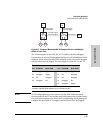
6-66
Configuring the Switch
Port-Based Virtual LANs (VLANs)
Configuring the Switch
To summarize:
Effect of VLANs on Other Switch Features
Spanning Tree Protocol Operation with VLANs
Because the Switches 1600M/2424M/4000M/8000M follow the 802.1Q VLAN
recommendation to use single-instance spanning tree, STP operates across
the switch instead of on a per-VLAN basis. This means that if redundant
physical links exist between the switch and another 802.1Q device, all but one
link will be blocked, regardless of whether the redundant links are in separate
VLANs. However, you can use port trunking or switch meshing to prevent STP
from unnecessarily blocking ports (and to improve overall network perfor-
mance). Refer to “STP Operation with 802.1Q VLANs” on page 6-44.
Note that STP operates differently in different devices. For example, in the
(non-802.1Q) HP Switch 2000 and the HP Switch 800T, STP operates on a per-
VLAN basis, allowing redundant physical links as long as they are in separate
VLANs. Thus, redundant links connecting a Switch 1600M/2424M/4000M/
8000M to the Switch 2000 or Switch 800T in a VLAN environment will not be
blocked if the links are in different VLANs.
IPX and IP Interfaces
There is a one-to-one relationship between a VLAN and an IP or IPX network
interface. Since the VLAN is defined by a group of ports, the state (up/down)
of those ports determines the state of the IP or IPX network interface associ-
ated with that VLAN. When a VLAN comes up because one or more of its ports
is up, the IP or IPX interface for that VLAN is also activated. Likewise, when
a VLAN is deactivated because all of its ports are down, the corresponding IP
or IPX interface is also deactivated.
VLANs Per
Port
Tagging Scheme
1 Untagged or Tagged
2 or More 1 VLAN Untagged; all others Tagged
or
All VLANs Tagged
A given VLAN
must
have the same VLAN ID on any 802.1Q-compliant device in which the VLAN
is configured.
The ports connecting two 802.1Q devices should have identical VLAN configurations, as shown
for ports X2 and Y5, above.


















